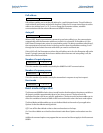
51
Reference Manual
00809-0100-4860, Rev BC
Section 4: Operation
January 2013
Operation
Once your scaled trim points have been entered as 2 and 10, you can now calibrate your
flowmeter by entering voltage measurements directly from the voltmeter.
4.1.7 Shed freq at URV
Shed Freq at URV function gives the shedding frequency corresponding to your URV (URV =
Upper Range Value). If the PV is Process Temperature, the Shedding Frequency at URV
represents the shedding frequency of the Volumetric Flow URV. This can be set by assigning
Volumetric Flow to PV and setting range values.
4.2 Advanced functionality
The Rosemount 8600D enables you to configure the flowmeter for a wider range of applications
and special situations. These functions are grouped as follows under Detailed Set-Up:
4.3 Detailed set-up
Characterize Meter
Configure Outputs
Signal Processing
Device Information
4.3.1 Characterize meter
The Meter Body variables provide configuration data that are unique to your Rosemount 8600D.
The settings of these variables can affect the compensated K-factor on which the primary
variable is based. This data is provided during factory configuration and should not be changed
unless the physical make-up of your Rosemount 8600D is changed.
K-factor
The Field Communicator provides information on Reference and Compensated K-factor values.
The Reference K-factor is factory set according to the actual K-factor for your application. It
should only be changed if you replace parts of the flowmeter. Contact your Rosemount
representative for details.
The Compensated K-factor is based on the reference K-factor as compensated for the given
process temperature, wetted materials, body number, and pipe ID. Compensated K-factor is an
informational variable that is calculated by the electronics of your flowmeter.
Field Comm. 1, 2, 7
Field Comm. 1, 4
Field Comm. 1, 4, 1
Field Comm. 1, 4, 1, 1


















